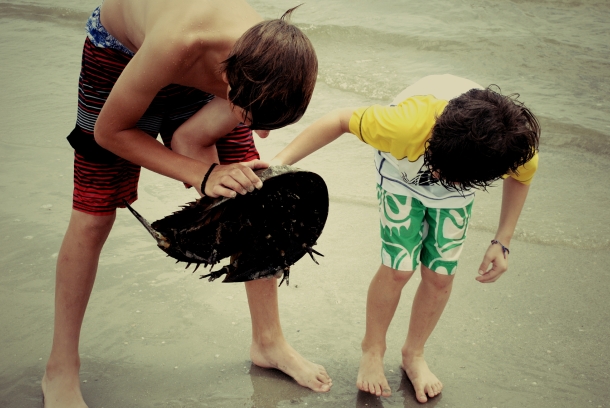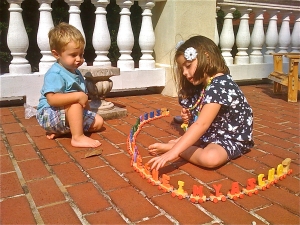Here’s a dad who built a weather balloon for his son’s favorite train. This beautiful video documents their adventure.
Tag Archives: parenting
Edible Schoolyard
I just devoured the most delicious book, The Edible Schoolyard, about the journey of Alice Waters–Montessori teacher turned restaurant owner–as she transforms a vacant lot behind MLK Middle School in Berkeley CA into an edible oasis where children learn to grow crops, cook and eat together–the story told elegantly with gorgeous photographs. There’s more to it. I can’t do the book justice at all.
Of course, it is everything Reggio is about. In fact, it is the soil of the Reggio garden project turned even more deeply, grown wilder and allowed to reseed itself–with older children and higher stakes.
It got me thinking in goals. 1) Work in the garden with my children on our day off this Wednesday. 2) The school garden is where I belong–either at my own children’s schools or at a nearby public one.
Whereas I’m Christian and I don’t attend services on Yom Kippur, I hope our day in the garden can be a way to observe it. I believe Jesus’s death atoned for my sins. When my kids are out of school for The Day of Atonement, I’m going to make it a day when we remember His sacrifice and our need for a savior. It’s the day to make amends to those we may have hurt. Those of us who have been broken know AA has a step for that–making amends–pulling our personal weeds, acknowledging them to others, making it right to them. And Christians know we’re all recovering from something, being human, sinning.
Nothing teaches humility like pulling REAL weeds…that’s what the kids in the Edible Schoolyard learned. Self-esteem is a meaningless buzzword. What we’re after is character–and character comes from hard work. Throwing the sack over your shoulder, taking off your gloves and scanning clean rows of beans, that’s accomplishment, that builds a quiet confidence, the kind that makes God smile.
Here’s the pledge: to spend Yom Kippur looking down at the weeds–and up to our generous, patient, loving Father.
Summer Harvest
LBug was out of school for Rosh Hashanah. We used the morning as an art day and invited a friend over to work with clay and paint a bit on canvas. I wish I’d taken pictures of the girls at work. I had great Reggio-inspired plans. We gathered tidbits on a nature walk, held the guinea pigs, talked about what they need in a home, read Home for a Bunny together. We were going to build homes for tiny plastic turtles out of the clay. However, the girls just needed to get to know the material, and we never actually made a finished product with the clay.
The holiday–a New Year’s celebration–reminds me to take stock of our summer.
It amazes me when I look back on it and want to share some of our harvest photos:
We took our studio to the sunshine.
We grew peaches.
We brought home three Silkie chicks.
We built a chicken coop.
We painted a chicken coop.
We lost our chicks. We adopted guinea pigs.
We wandered among wild horses.
We observed a horseshoe crab.
We walked back to our boat in the rain.
Bringing Reggio Emilia Home
Hungry for all things Reggio, I just ordered a couple of books on the subject.
The first one I read was Louise Boyd Cadwell’s Bringing Reggio Emilia Home. It’s an account of her year as an intern in the preschools of Reggio Emilia, Italy, and then her first projects with students when she returned to the US, at the College School in St. Louis.
I absolutely devoured this book. I was anxious to see what Reggio looks like in practice. This book walked me through two main projects with children, a tree adoption in Italy, and a bean and garden project in St. Louis. It didn’t bog me down in pedagogy. It took me on the actual ride. In that way, the book practices Reggio itself. It is a documentary of a learning journey, and no doubt the journey of writing the book was a transformative process for Cadwell and informed her future endeavors.
In the same way, this blog is for me part of the learning process. It documents part of what has been my own journey, from artist and writer to parent, and possibly to–I’m guessing here–teacher some day.
I started searching for good early education practices because I was unhappy with the regimentation and emphasis on handwriting at my daughter’s preschool.
That’s when I started the blog. I began to make a seriously conscious effort to expose my daughter to hands-on, living, breathing experiences in nature and with materials, experiences she wasn’t getting at school, but which I was sure in my gut that she should be getting
I met my neighbor and we built a stile and a friendship. As serendipity would have it, she’s an art teacher at an elementary school that has recently moved to a Reggio-inspired curriculum. We began collaborating as parents–enter The Hippie Mothers Club.
Then, as my daughter slogged through pre-K worksheet hell, and I started the process of applying her to private elementary schools, I found a great, GREAT, awesome, wonderful preschool for my son.
As I got to know this preschool, I began to see that the magic of it stemmed from it’s adoption of the practices of Reggio Emilia, as well. It is a school that other schools come to study. The classrooms look like art studios and science labs.
So that’s where I am now. I’m realizing that the projects I was doing with my daughter, as well as my own past life as an artist, poet and amateur naturalist, and where I want to go in life–are all dovetailing beautifully with this Reggio Emilia attitude.
I had to know more. I ordered the books. I’m now reading 100 Languages. And whereas, I know this will become my handbook in the future; I’m also glad that I read Bringing Reggio Emilia Home first.
It was what I needed–the shorthand journey and living description of what Reggio is–no politics, no big research. I was asking myself, “What the heck am I getting into?” And Louise sat me down and told me her story, friend to friend, teacher to engaged parent, mentor to mentee. Thank you, Louise!
I just watched this video, How to Write Like An Architect. As an artist and writer, I’ve always aspired to handwriting more like this. And it dovetails nicely with parenting right now, too. LBug is in kindergarten and, like it or not, she is being taught a crash course in reading and writing.
I’m not sure that, at 5 years and a month or two, she is at all ready for these, developmentally. She doesn’t know her lower case letters at all, and I feel like I should teach her so that she isn’t behind, but I also sense that she isn’t very interested and isn’t very able yet to do it yet either. The problem, if you ask me, is that she is facing a curriculum better suited to six year olds. About half her class is six already, as a matter of fact, and I don’t fault those parents one bit, who held their late spring and summer birthdays back. The curriculum practically demands it.
We could pull her out and homeschool her–there goes my own interests, hobbies, business ventures, sanity, etc.
Our public school does not seem an option–it is going through quite a few transitions, and I cannot imagine turning my child over to a system whose core beliefs we question.
Do we find another private school whose curriculum I like better for now? Moving her seems like it would give her the wrong signals.
So she is where she is, and we’re hoping that the struggle this year builds character.
But I’m wondering, is all this learning to write in the lines so early crushing her creativity and zest for learning?
I’d like to write like an architect, or like a good writer–saying the most in as little time as possible, with the words still being alive.
And I’d like to parent like an architect as well, with the whole future adult person’s structure and strength in mind, not just the facade.
Bottle Cap Art
Our bottle cap Christmas Tree is coming along. Here’s a secret, a screwgun makes the impossible possible. And it makes little boys feel like men!
Check out more bottlecap treasures over at www.artgrange.com. So cool.













